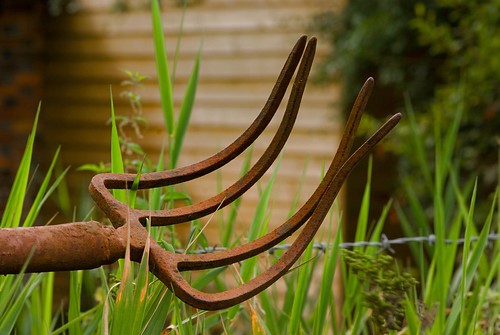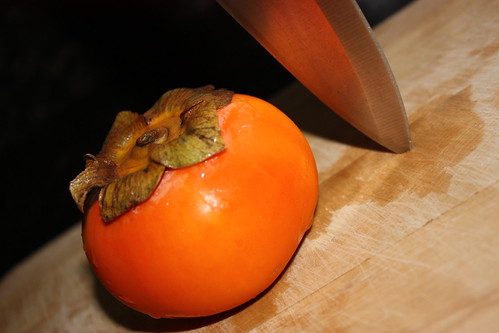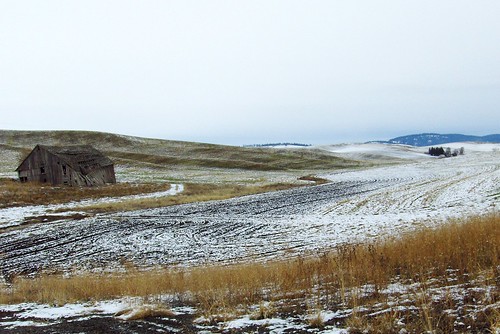Archive for November, 2009
Winter Maintenance for Garden Tools
With the end of November quickly approaching, nature has signaled the end of the growing season for most parts of the country.
Now is the time to put your garden tools to bed as well, sort of speak. Learn how a few moments of preventative maintenance can help extend the life of your tools by clicking here, and keep your tools in good working order for many more seasons to come.
![]() photo credit: lovestruck.
photo credit: lovestruck.
Canned Pumpkin Shortage!
Heavy rains and rotting pumpkins causes shortage in canned pumpkin supply for the holidays. To read more click here
But, don’t fret. Who needs canned pumpkin anyway. We’re homesteaders and can make it from scratch – real scratch. Try this tried and true alternative (courtesy of a fellow homesteader). Your guests will never know the difference and you may just have found a new holiday tradition.
Better Than Pumpkin Pie
1 cup peeled and cubed butternut squash
1/2 cup peeled and cubed carrot (they add a bright orange color and sweetness)
3/4 cup lightly packed brown sugar
1 tablespoon cornstarch
1 egg, beaten
1 cup evaporated milk
1 1/2 teaspoon ground cinnamon
1/2 tsp ground nutmeg
1 pinch ground allspice
1 pinch ground cloves
1 pinch ground ginger
1 (9 inch) unbaked pie shell
1 pinch ground cloves
DIRECTIONS
1. Place squash and carrot in a saucepan with enough water to cover. Bring to a boil, and simmer over medium heat until tender, about 15-20 minutes. Drain, and cool.
2. Preheat oven to 350 degrees F (175 degrees C).
3. In a blender or food processor, combine butternut squash, carrot, brown sugar, cornstarch, egg, milk, cinnamon, allspice, cloves, ginger, and nutmeg. Process until smooth. Pour into the unbaked pie shell.
4. Bake in preheated oven for 50 minutes, or until a table knife comes out clean when inserted in the center.
For a sinfully delicious topping, whip heavy cream with a little sugar, vanilla and cinnamon.
NOTE: Since most hard winter squash are interchangeable many of them can be substituted for the butternut squash in this recipe. Experiment with different varieties to discover your family’s favorite.
Life is not all about work…
…and neither is homesteading.
Personal Journal – November 22, 2009
It’s a point I try to make often to my more skeptical town friends. Sometimes even we homesteaders have those quiet lazy days where little is thought about and even less is accomplished. Yesterday was one of those days. We woke up late, about 7:30 (a luxury that is not afforded us when there are sheep in the barn). I could hear a young rooster trying to master his crow. The hens were scratching, and fluffing themselves in the dirt, chattering as hens always do. The dogs were on patrol. I could hear them in the bushes, sniffing and prowling about, looking for treasures. These are the kinds of mornings that beg you to stay in bed and quietly listen to the sounds of the farm. You can learn so much by just listening.
By the time I stumbled through the house, Brianne was already laid out on the sofa, buried under a mound of quilts making friendship bracelets and watching a movie I found at a local book sale a few weeks ago. Dakota was at her feet begging for more room to stretch out. Last nights fire was gone, but you could still hear crackles and pops as the embers cooled and died. It was dark and lonely, but could easily be revived with a little encouragement and a few pieces of kindling.
Breakfast was a steaming bowl of porridge, topped with nuts and brown sugar, bananas and milk. By the time it’s ready I’m on my second cup of tea (i’m not a coffee person…so not a coffee person), Earl Gray with a splash of milk and a bit of sugar. From the kitchen I can hear the twitter of birds. I don’t know what type; we have become a kind of way station for passersby’s. Some have a sharp trill in their voice, while others chirp on and on for quite awhile. The crows are back, I can hear their caw, caw, caw, but no sight of the red tailed hawk that perches himself on the arbor.
No – life is not always about work. Sometimes it’s about quiet, easy mornings, warm and safe in a simple home. Oh, don’t get me wrong, there will be work done this weekend, but it will be slower, less rushed, with less urgency for completion than other days. I have a few errands to run in town, the truck needs gas for the coming week, Brianne’s birthday is next week and I need a card, the nesting boxes in the coop need to be refilled and the floor raked out. There’s mulch to lie out in the garden and I want to finish the quilt I’ve been working on. Yes, there will be lots of work this weekend. But there will also be time for sitting back and listening to the sounds of this farm. Time for a second (or third) cup of tea, time for snuggling with a mangy dog trying to hog the sofa and time to just relish what we’ve built with our own two hands. No – life isn’t all about work. A lot of life is about paying attention and enjoying what comes our way, the fruits of our labor. And, if we get a few bumps and bruises or have to tend animals in the rain so be it.
A Mother’s Hands
Personal Journal – November 16, 2009
A Mother’s Hands
Last night, while I finished cleaning the kitchen, I looked down at my hands and thought to myself, “my hands are not pretty.” In fact, they’re quite the opposite. The year’s of farming and raising livestock show clearly in the callouses and scars. Newer scratches and wrinkles are a testament to my love for what I do and how I live my life.
As I stood there staring at my hands, I see dirt embedded from days of working without gloves. My pinkie is cut; an encounter with a piece of fence wire and a piece of skin is missing from one of my knuckles. I notice long healed scars, one where I was bitten by a ewe I was trying to worm and another where I was accidently clipped with hoof trimmers instead of the sheep.
My nails are short and uneven, broken and chipped. My hands are strong, but my nails are not. They peel and chip at the slightest bit of work. They haven’t seen a manicurist in years. And, polish is a luxury in time I can’t afford. I use to go. Before the demands of work and family, farm and animals became my life.
I use to go.
But, that’s okay. These small not so pretty hands are a mother’s hands; hands that work hard and love deep. They are strong yet gentle. They might make most people cringe, but they built the barns that shelter our animals, plowed the gardens that fill our table and laid the pipes that water them all. They chop and stack the firewood that keeps us warm. They scoop grain, throw hay, plant seeds, pick fruit, bring new life to our little farm and care for a home and a child.
They are not pretty hands. They are a mother’s hands.
As I stood at my sink, soap suds dripping from my hands, I had to chuckle to myself. I gave up on pretty hands a long time ago. I traded them in for strong, caring hands; hands strong enough to sign the mortgage for our little farm, firm enough to raise a child alone and gentle enough to keep it all moving forward and balanced.
We make choices in our lives. And, sometimes those choices include sacrifices. I have paid a price for my years of working hard without protection – ugly hands.
But, I don’t care. I traded in my pretty hands for strong hands, a mother’s hands and that makes them beautiful hands.
![]() photo credit: Tamara van Molken
photo credit: Tamara van Molken
Winterize your hands and feet
Winter’s cold winds and harsh temperatures can wreck havoc on a homesteader’s hands and feet. But, with this easy and inexpensive solution you can have baby-bottom soft skin all winter long.
After a bath or shower, or when evening chores are finished and you have time to sit, simply slather a thick layer of lotion over hands and feet, then put on a thick cotton sock. Yep – on your hands too. The warmth created from your body’s heat and the sock causes pores to open, allowing the lotion to soak deep into your skin. You can sleep with your socks on for even better results.
Try this several times a week and you’ll make it through winter without sore, cracked, rough hands and feet.
![]() photo credit: telepathicgeorge
photo credit: telepathicgeorge
Greening Household Cleaning
Many commercial cleaners pose a variety of health and environmental hazards, from eye or skin irritations to chronic illnesses. With the onset of winter and the tendency to stay indoors during these colder months, fumes from chemical cleaners can be especially harmful.
Why not make yourself an early New Year’s resolution and start going green with your cleaning.
Check out this article for more information, along with nontoxic recipes for making your own cleaners and a list of store bought green cleaners.
Make Your Own Garden Trellis
Hint & Tip
Make your own garden trellis
Before you chop up grape cane or berry vine pruning’s for the compost, consider saving them to make your own garden trellises.
Simply pull off any leaves and scrap off the thorns and you have the perfect material for making trellises that can be used for vining peas, beans or even small cucumbers.
Before the canes dry completely, take several sturdy straight pieces for the uprights, then twine the remainder around the uprights in the diameter you want. Leave room at the bottom so the trellis can be pushed into the soil.
Once finished, tie the intersections to hold the trellis together. Vine trellises will last a few seasons and can then be chopped up and composted. You’ll save money on buying premade- trellises and your garden will have a fine country feel with natural made trellises.
(if you don’t have grapes or berries on your suburban homestead you can also use small diameter saplings)
Extend the Life of Kitchen Sponges
Tip & Hint
Extend the Life of Kitchen Sponges
There’s nothing worse than spending good money on kitchen sponges only to throw them in the trash when they get sour and moldy smelling. But, with this quick tip your kitchen sponges will last much longer.
Simply place the sponges in the dishwasher each time you run it and they will stay fresh and useable for a longtime – saving you money.








Recent comments
Aenean nonummy hendrerit mauris. Phasellus porta.